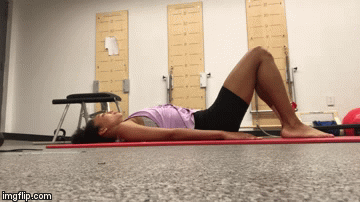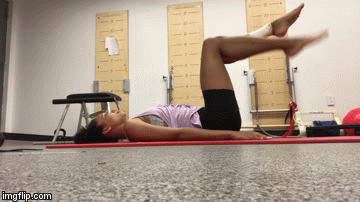By the time I was 11, I was dancing at the School of American Ballet, the school associated with New York City Ballet. I had just stopped doing rhythmic gymnastics and decided to focus all my attention on ballet. And at 13 I had my first major injury.
I remember what class and exactly what step I was doing when it happened. I went to take off for a turn and subluxed (a temporary, partial dislocation) my knee cap. I couldn't walk and was carried out and taken to the emergency room.
I remember waiting in the emergency room with my mom and telling her how upset I was about missing my next ballet class of that day. They did X-rays and... no broken bones.
It swelled to the size of my thigh. There was no distinction of the knee from my hip to my calf. It felt stiff and full. I went to a doctor who had to drain two large syringes of fluid from my knee. But it made it feel a lot better and I had better motion after that.
I got an MRI to see what sort of damage had occurred during the subluxation. We found that during the shifting of the knee cap I had broken off cartilage behind my knee cap in two places. One of which was floating around in the knee. I would need immediate surgery.
In some ways it was nice to have such a definitive outline of the problem and the solution. Majority of injuries that are the most frustrating are those where doctors cannot find the problem and don't know how to fix it.
So I had the surgery and it went as well as could be, considering it was a difficult procedure. I was fitted into a hip-to-ankle brace and crutches. And sent home same day with an anesthesia administration in the entire right leg
I didn't get back to dancing for about a year.
That experience changed me forever. I had never really had a major injury before that so I learned a lot about my body, physical therapy, and the ins and outs of the recovery process. I think it matured me as a dancer. I went back to dancing but I was smarter and more aware.
Shortly after that injury I was applying for high school. All the applications had to an include an essay and I wrote about my experience with this injury. I titled it "A Blessing in Disguise".
Even though I will carry the scars of that injury for the rest of my life, it's all in how you look at it. All of the injuries I have sustained since then, I am always reminded that it's more about how you stood up then how you fell.
We all struggle and some more than others but it's fascinating how much we can recover from. Your body for example is constantly finding ways to heal itself on its own. It never gives up. It's always reinventing itself. And there is definitely something to be said about the mind body connection of healing. There is an article in The Guardian, that interviews Jo Merchant the author of Cure: A Journey into the Science of the Mind over Body. In the interview she says
But there is a scientific explanation: factors such as social support and positive expectation inherent in these treatments can trigger physiological changes that ease symptoms.I found the interview to be very interesting in learning about unconventional medicine and the true healing power of your mind. Check out the full interview here.
I think the idea of feeling less than (feeling inadequate and useless)... is something that is common when people get injured. It comes from being physically limited in some capacity and the emotional toll injury can take on dancers specifically, as I explained my one of my previous post, Depression is anger turned inwards. But I'm a strong believer in everything happening for a reason and there's a bigger picture behind the events that happen in life.
If I hadn't injured my knee, I wouldn't have gained that perspective and experience. I wouldn't have been left back a level in my ballet school, which ultimately wouldn't have landed me in my dream ballet company. We often don't see the fruits of our labor until much later on.
 |
| Photo by Paul Kolnik |
My advice would be:
- Trust your body is doing all it can to help you
- Ride the wave of your recovery with all its ups and downs; meaning the injury will take the time it needs to recover no matter what you do or don't do so you have to just take every day as it comes and accept the process
- Try to stay positive, do things that make you happy even if it's in a limited capacity
- Explore new interests, it will help expand your perspective
- Be open to new cross training and moving in new ways
- Remember that you are valuable, just as you are, right in this moment no matter what injuries you have sustained
As I was writing this post a friend of mine posted this quote on her instagram story and I thought it was very appropriate!
Just as the title of this post states, changing your perspective on injury is very important to successfully get through it and move on. Sometimes injuries can be a good thing because they teach you lessons and you grow from them. It isn't all bad. I hope sharing my experience has helped you feel better about whatever it is you are going through and made you feel more optimistic.












